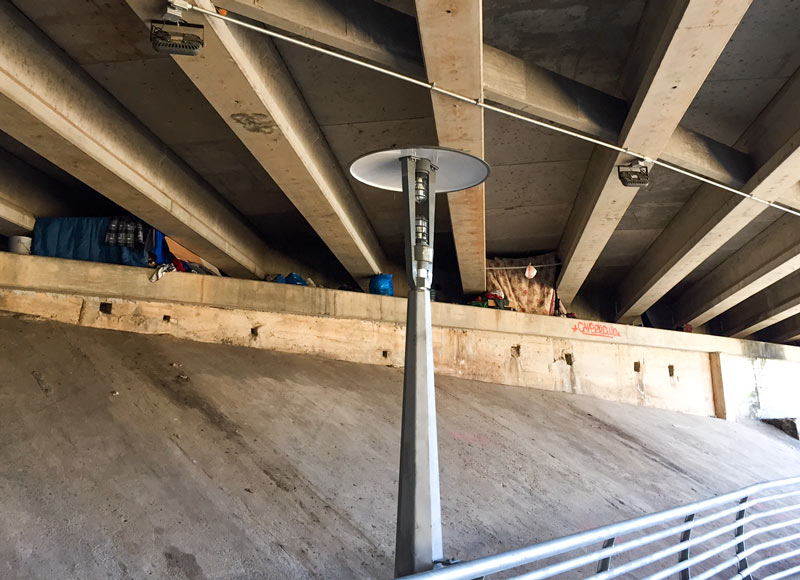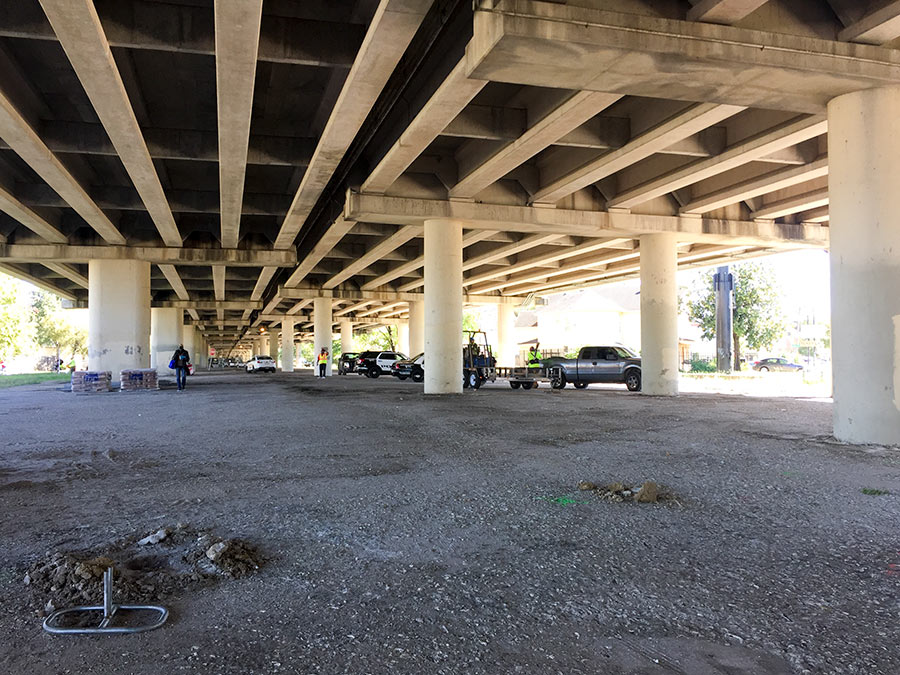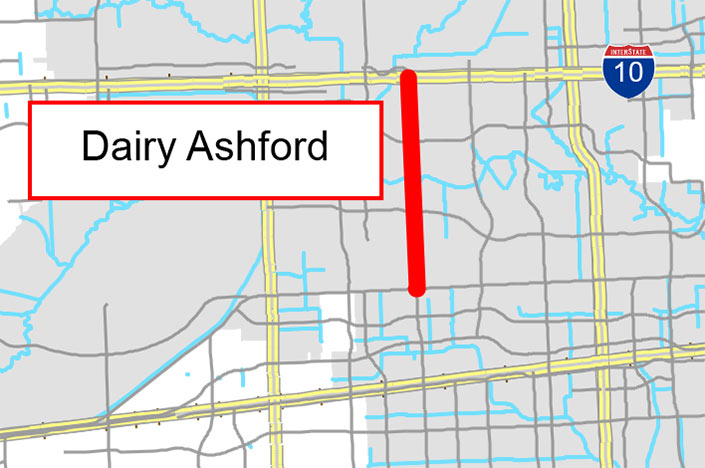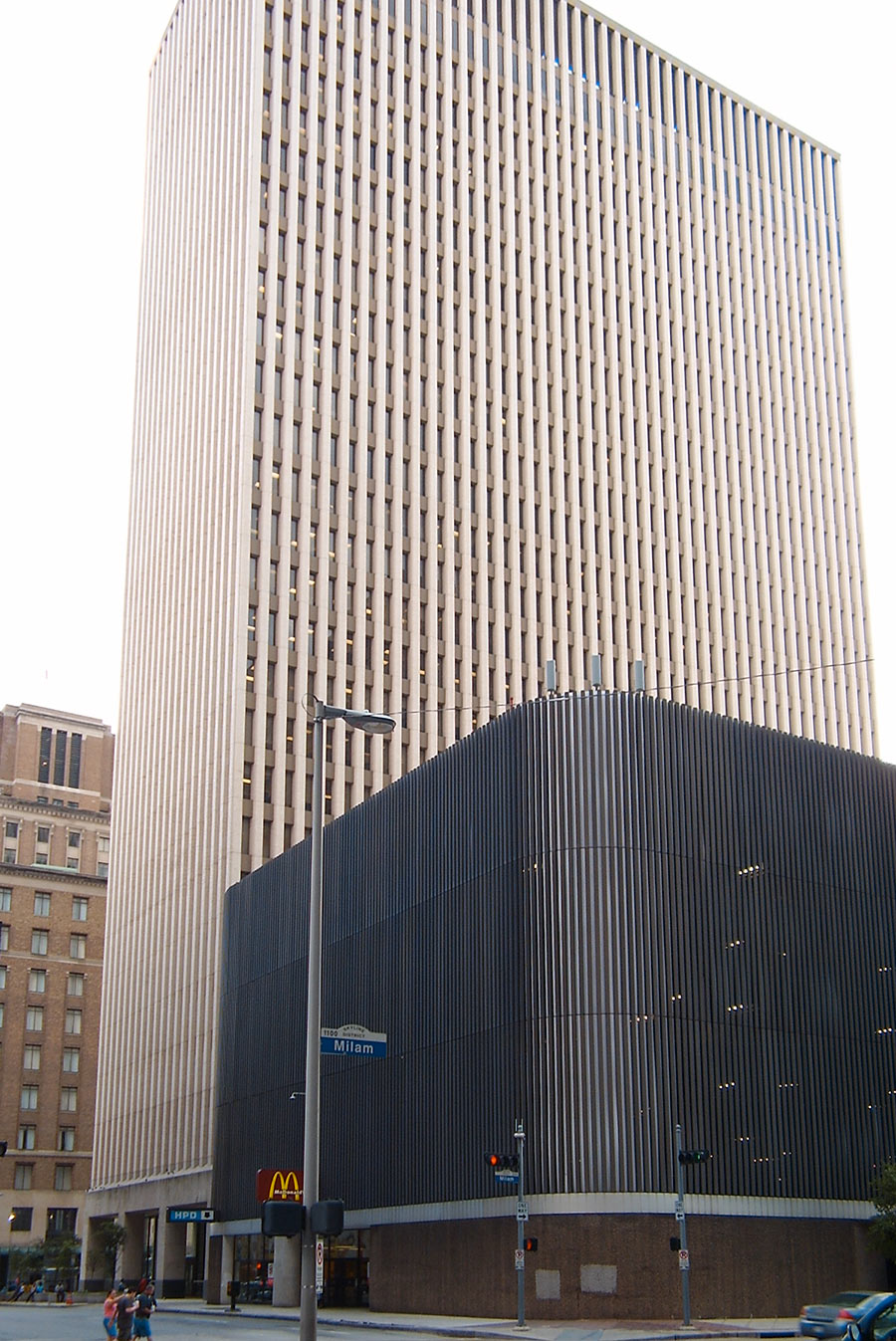
Among the flurry of in-the-works policies Mayor Turner announced yesterday related to reducing the number of homeless folks in Houston: some staffed bare-bones shelters consisting of at least a fence, a roof and a bathroom, either under overpasses or on private land. Just where would those be set up? The city says they’ll be looking for suggestions from city council members and communities of spots in their own districts where shelters and services might be a good fit.  Per Rebecca Elliott’s report, Turner told the Chronicle this week that he thinks it’s “important for people who are saying ‘we don’t want them here’ to join in with us in helping to identify acceptable locations.”
Here’s a list of other plans floated yesterday, none of which yet come with an expected price tag:
***
- A push to get 500 more folks into permanent housing in the next 6 months
- A citywide ad campaign scheduled to start up later this month to discourage people from giving spare change, and to instead text donations to Houston service groups
- a ban on tents (though not on sleeping outside)
- a “street obstruction” ordinance aimed at making activities like panhandling and aggressive window washing into potential misdemeanors
- A trial program to help panhandlers get jobs
- Asking the Texas Legislature to do something to boost mental illness support
The related press release put out by the city yesterday says that no more than a third of Houston’s estimated 3,600 homeless folks (down from around 8,500 in 2011) are actually sleeping on the streets these days; and that Star of Hope’s Reed Rd. campus should open up more shelter beds later this year as well.
- City Pursues Strategies for Homeless, Panhandlers [City of Houston]
- Turner’s Homeless Plan Includes ‘Low-Level Shelters’ Under Overpasses [Houston Chronicle]
- Previously on Swamplot: Buffalo Bayou Cleanup Extends to Camp Beneath the Louisiana St. Bridge;Â Houston’s Homeless Population Has Dropped Dramatically Over the Last 3 Years;Â The Secret Homeless Caves Under Downtown
Photo of previously cleared homeless encampment under Louisiana St. Bridge downtown: Christine Wilson





With respect to the dignity of all homeless, it would seem , to me , that a district or warehouse area along 610 north going east or on hwy 288 south of 610 would be an area to locate all facilities to help and direct the homeless population. Basically, the homeless now congregate around food pantries, shelters and food handout locations and bus terminals scattered around downtown, Eado, midtown, Herman Park, and in our other parks . This gathering, although appearing innocuous, severely hampers and hinders constructive change and growth toward a dynamic , tourist and resident alike, pedestrian and business friendly environment where people can feel , whether perceived or actual; safe. Without a safe environment , be it physically safe, or emotionally/mentally safe, there will be no environment other than what the street….the homeless dictate….on the street. That is unacceptable and , if you don’t think so, see where all the other new and old development of metro Houston has gone. Why? Is it because development follows homeless congregation? Because Houston has yet to establish itself with a complete downtown/midtown/museum district urban core, which is what people identify the city as being, it will always be incomplete because it cannot go beyond this guilty feeling of redirecting the amenities for the homeless away from the very needed areas of development in the city of which the homeless have taken over. Direct and locate all services for the homeless in this area away from the core of the city on hwy 610 or 288 south in a created or renovated warehouse district with the appropriate housing, food distribution, shaded park, fountain, counseling, policing and basic medical care. Separate the families or single women with children from the men and the violent/ mentally ill from the rest of the homeless. Provide a small bus service to the metro bus transit area in downtown that would run a couple times a day. Have a police unit enforce vagrancy violations and transport violators to this homeless warehouse district/area. In this way we are not building a city around a homeless population, being held for social ransome by street values and behavior but are building a city that will grow for all people and still enable homeless people to be helped in a humane and decent way.
The “low level shelters” proposal is the most fascinating to me, as it seeks to meet the short term needs for housing in a given community, presumably on the way to a longer term accommodation that is not quite yet available. The degree of resistance from communities encompassing a proposed low level site will depend on the details yet to be released: monitoring, counseling services, ingress, egress, sanitation, etc.
BTW, did the word “astrodome” pass anyone’s lips at yesterday’s announcement? I hear it has a roof and working toilets.
Tom, that took guts and makes sense. Brace yourself for the ludicrous comparisons about to be posted.
1. Serious comment: If people would STOP giving change, the panhandlers would move to greener pastures. On my commute from the medical center, there are crews of bums working every corner of every major intersection. They wouldn’t be there if cash wasn’t flowing. Toughen up, fellow Houstonians, and resist giving change.
.
2. Not so serious comment: The City wants a suggestion of where to put these people? How about the border with Sugar Land or Katy? I’d suggest Baytown (on the east side) but no one wants to live over there – even the bums.
The way I’ve always seen it (and recently confirmed by the Mayor’s statement), the remainder of the vagrants are there by choice, despite numerous and abundant avenues of help. They chose to exit the society and hence have no rights or privileges, therefore the focus should not be on accommodation but on elimination, either through jailing or shipping off to more naive places like California. Jailing this lot will spread the word that Houston is not a place to go for future hobos and one way bus tickets to California are pretty cheap.
Tom makes a great point.
IF Judge Emmett really wants to keep the astrodome then put the homeless in there. I would rather it be used for something meaningful rather than another parking lot.
They are feral. If you want to toss food to them fine but don’t expect your “services” to be rewarded. They aren’t misguided or down on their luck.
@ Tom: A lot of the homeless would prefer to sleep outdoors in good weather and only come to the shelters when subjected to duress. A cold snap can quickly overwhelm the capacity of the shelters. Yes, they tend to congregate around the fringes of the downtown area because of services available to them, but I would imagine that it’s more than just that. The downtown area offers better begging opportunities because there are more ordinary people on foot in a public space. In addition, they probably feel safer being there than in some forgotten suburb or in an industrial park. Substance abusers and some of the mentally ill probably have it better off just camping, and many wouldn’t be welcomed in any shelters in their preferred condition. Finally, many keep odd hours, are not regular commuters, and providing some kind of a twice-a-day shuttle just wouldn’t work out.
.
I appreciate your intent to try and treat them with dignity, but I’m not sure that the homeless are as easy to warehouse as it may seem. They have as many rights to a sidewalk as anybody else, and they’ll avail themselves of those rights at their own discretion. By contrast, neither the citizens of Houston or the suburban commuters or tourists thereof have any right to an “urban core” sans homeless that arbitrarily spans any particular set of neighborhoods bearing contrived historically-meaningless monikers, such as Midtown or EaDo. If development is happening elsewhere, so be it; such a place is urban or will be soon; and you and the tourists can go there. And if such a place is deemed insufficiently “authentic”, do bear in mind that if tourism really did take hold in the place you think is the “urban core”, it too would cease to be “authentic”. For evidence of that, visit just about any UNESCO World Heritage site anywhere in the world — and maybe start with New Orleans.
.
Tourism in and of itself is a bit of a curse, and the beggars and substance abusers are drawn to it like flies to garbage. Worse still, tourism as an industry creates jobs but they don’t often pay very well and most of the profits go to companies that aren’t based in the same city.
San Antonio did it right when they built Haven for Hope. The idea of putting tents and porta-potties under freeway overpasses just sounds like something the HUD and DOJ officials (and advocates) would dismiss out of hand. And I can’t say I blame them.
.
My thought would be to start by buying the old Southwest Inn. Refurbish the rooms to be SROs. And then build a new front building with space for drug treatment, meeting rooms, offices, and the like.
.
The cool thing about the site is that if they need to, they can expand it in the future by buying out the “Romana ” hotel (too run down to even keep being a Ramada) and the Red Door Inn (your classic hot sheet motel that’s become a real nuisance). More than that: Harris Health’s MHMRA offices are really close. There are a lot synergies to be had.
.
The only thing they didn’t do so well in San Antonio was that Haven for Hope doesn’t have 24 hour intake. This one should. That way you won’t have homeless people wandering around nearby streets when it’s closed.
Texas Legislature needs to do something about boosting mental illness support for its elected officials and supporters.
@ZAW I’m all for helping the needy but San Antonio spent over $100 million building that homeless camp. Not sure that would be the best use of funds. I’d be in favor of a stronger anti-panhandling campaign. People’s willingness to give money constitutes demand for panhandling.
Just “tossing them in jail” is not at all a viable solution. Most homeless people have a mental illness of some sort, and forced incarceration is only going to exacerbate their symptoms. And jails are NOT a substitute for good, long term mental health treatment. Most homeless people can’t afford long term follow-up anyhow. Nor can they apply for government aid, since, they are well…..homeless.
IMHO, offering unconditional housing is probably the best we can do. And by that I mean there are no stipulations. You need shelter, you get it. Regardless of existing drug or alcohol abuse. I know that’s a tough one, it doesn’t seem fair to give something to a person that’s not even “trying to get better.” But some of these folks can’t get better. The least we can do is give them someplace to shelter.
Some of these people need to be institutionalized. Approximately 1/3 of the US homeless population (estimated at around 200,000) falls in the schizophrenia spectrum I don’t know a fair or constitutional way of going about it but it would protect them and the public. These people gain no benefit from being on the streets with hardened criminals, constantly being exposed to rampant drugs and violence, and going in and out of jail. There are certainly a number of people who are homeless and suffering from addiction related illness that need a different type of intervention but for those with refractory mental illness this seems a reasonable consideration.
Homelessness isn’t even the core problem for most of the homeless. Their problem is an inability to hold even minimum wage jobs, primarily due to mental illness or substance abuse addiction. I support efforts to solve those problems so that the homelessness takes care of itself. In the meantime, I also support a restriction on panhandling as it will be difficult to get those with alcohol and drug addictions into treatment as long as they are able to fund their addictions via panhandling.
Good luck getting bums off of drugs, Neil.
By allowing homeless populations to congregate and take over streets,parks , or wherever they may congregate without a plan becomes a never-ending social problem. We cannot eradicate it but must provide for basic needs as we address the humanity of it. By addressing where this help is administered shows a wisdom and concern for the greater good. By ignoring the greater good we become something less.